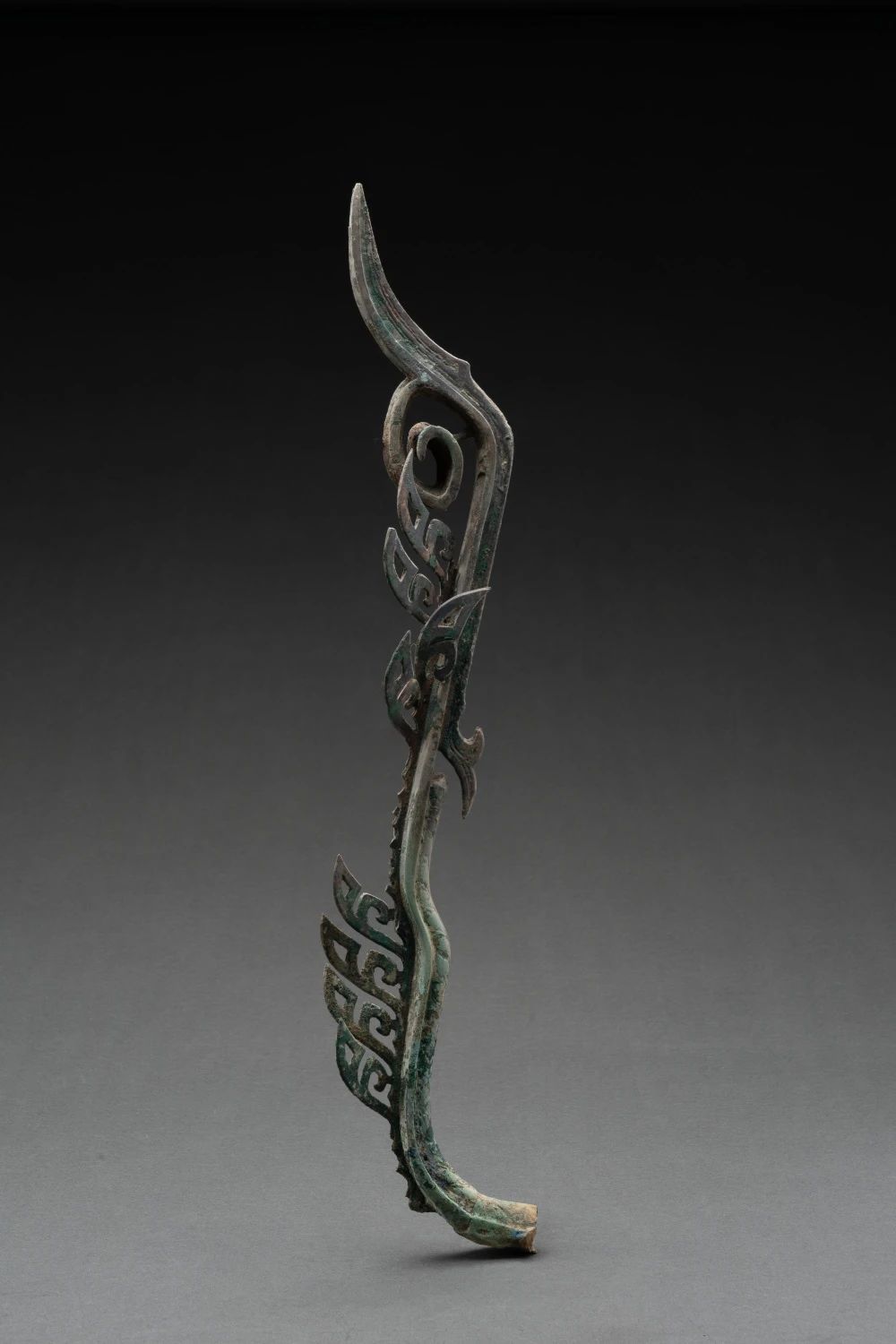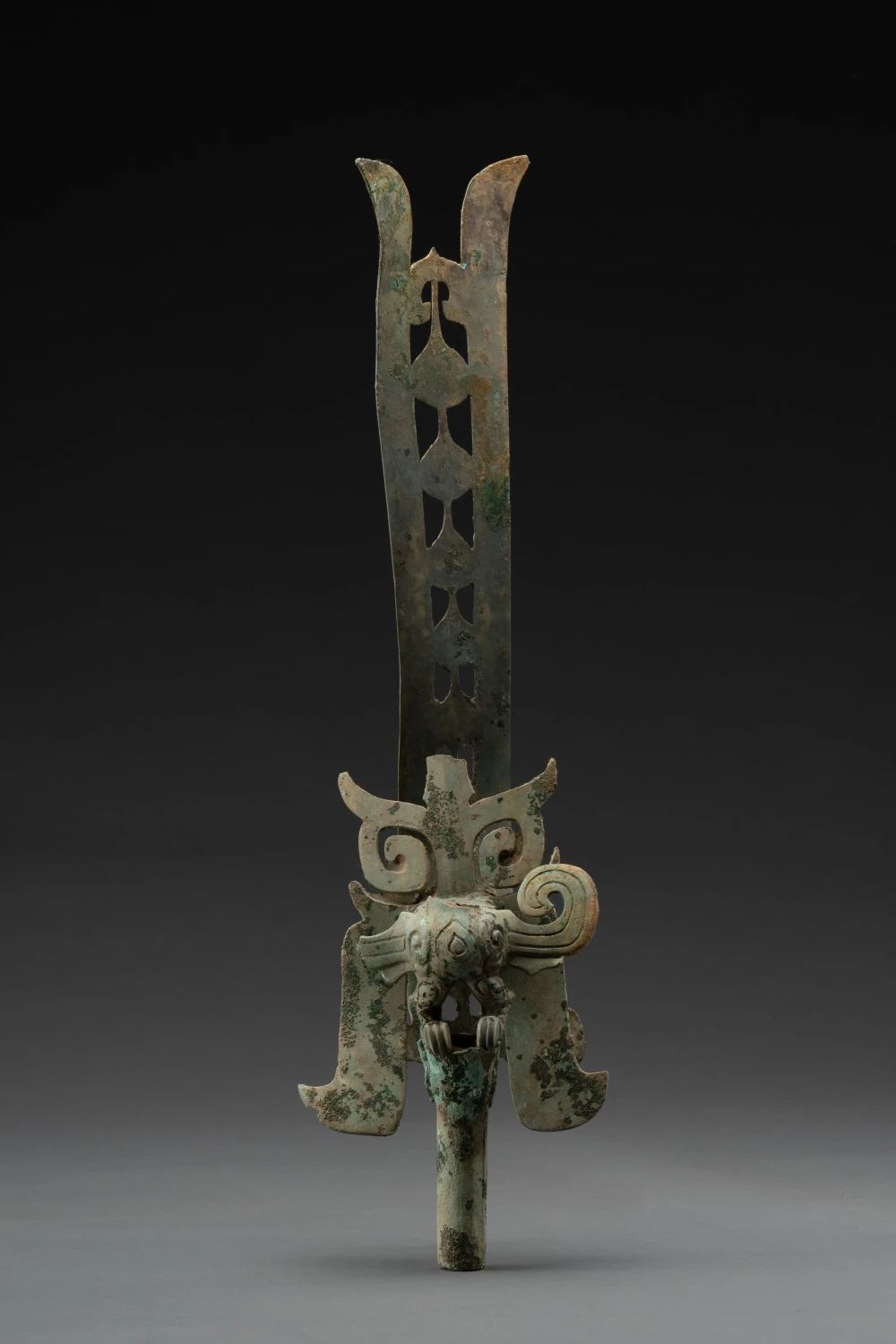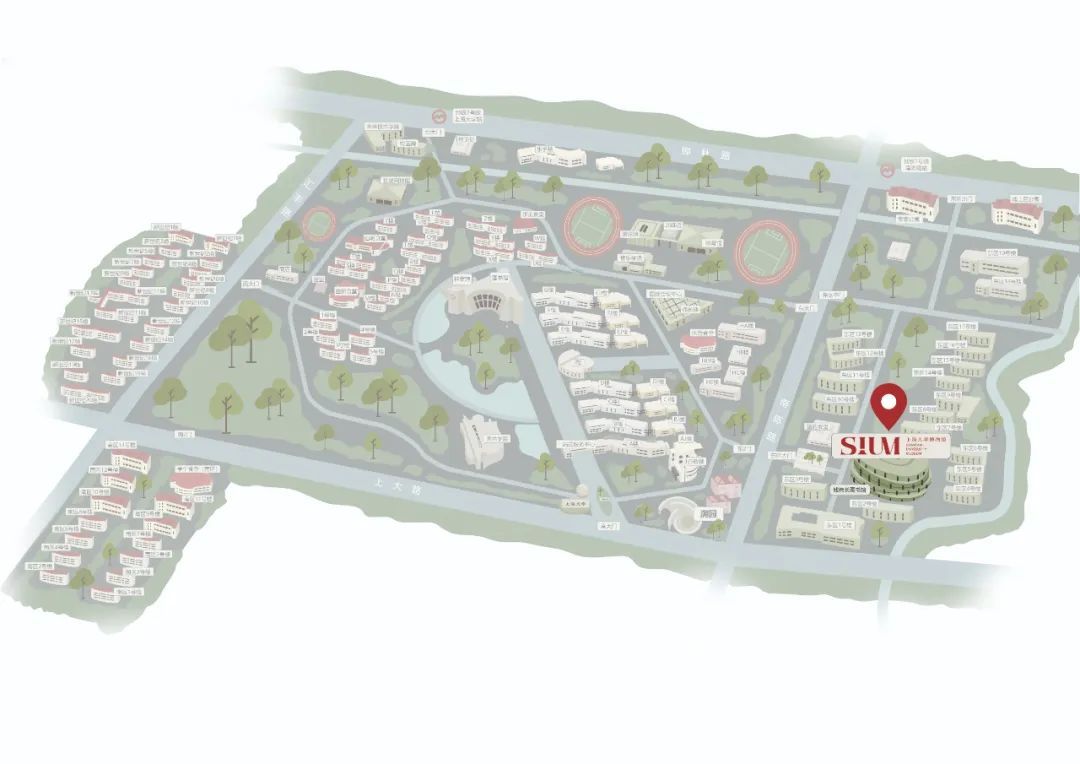青铜饰

· 商代后期(公元前1300年—前1100年
· 长11厘米,宽4厘米,高52.5厘米
· 2021年出土于四川广汉三星堆遗址三号祭祀坑,K3QW:900
· 四川省文物考古研究院藏
· Late Shang Dynasty (1300B.C.-1100B.C.)
· L.11cm; W.4cm; H.52.5cm
· Unearthed from No.3 sacrificial pit at the Sanxingdui Site in Guanghan, Sichuan, in 2021,K3QW:900
· Collection of Sichuan Provincial Cultural Relics and Archaeology Research Institute
整体细长,呈羽状。顶部分歧,一端上扬收成尖端,一端向下勾卷。中部一侧饰有四个云纹羽形镂空饰件,其中一个变形向另一侧弯曲;其附近铸有分尾饰件,上有单勾凹线。下部亦饰有四个云纹羽形镂空饰件。推测该青铜饰可能是某类重要器物上的附着装饰。
三星堆遗址出土的这些铸造精美细致的青铜饰表明,早在3000多年前,青铜铸造业已是古蜀国的重要手工业门类,其青铜文明程度达到了当时的最高水平。这些青铜饰显示出古蜀人丰富的想象力和创造力以及高超的青铜制作技艺。
This bronze ornament is generally slender and in the shape of feather. At the top, there is a bifurcation, with one end curving upward to a pointed tip, while the other end curling downward. On one side of the middle section, there are four cloud patterned feather-shaped decorative parts in openwork, one of which bends towards the other side. There is an ornamental part in the shape of a forked tail, with single concave line on the surface. The lower part of the ornament is also adorned with four cloud-patterned feather-shaped ornamental parts in openwork. This bronze ornament is likely an attachment on a certain type of significant object.
These exquisitely-cast bronze ornaments unearthed from the Sanxingdui Site indicate that bronze casting was already an important craftsmanship industry in the ancient Shu Kingdom as early as over 3,000 years ago and the developing level of the bronze civilization in the ancient Shu Kingdom reached the highest level at the time. They affirm that the ancient Shu people had honed rich imagination, extraordinary creativity, and perfect craftsmanship in bronze casting.
青铜鸟

· 商代后期(公元前1300年—前1100年)
· 长15厘米,宽10厘米,高55厘米
· 2021年出土于四川广汉三星堆遗址三号祭祀坑,K3QW:808
· 四川省文物考古研究院藏
· Late Shang Dynasty (1300B.C.-1100B.C.)
· L.15cm; W.10cm; H.55cm
· Unearthed from No.3 sacrificial pit at the Sanxingdui Site in Guanghan, Sichuan, in 2021, K3QW:808
· Collection of Sichuan Provincial Cultural Relics and Archaeology Research Institute
该器物从前至后可分为三层。最前层青铜鸟头部残,双翼外张,右翅残,尾羽弯折上扬,腿部饰卷云纹,两足短小,脚趾突出,紧紧抓握柄部,推测柄部插件可能接续其他物体。中层呈“山”字形,上为卷云纹样,两侧为对称垂羽状饰,其后有长条形镂空牌饰,最高处为对称羽翼,其下中部图案似银杏叶。器型整体线条流畅,形象灵动,极富想象力。
鸟在古蜀信仰中有重要地位,三星堆青铜器中有大量鸟形象,它们或是祖先的化身,或是太阳的象征,或是沟通人神的使者,都是当时古蜀人对鸟崇拜的真实写照。
It can be divided into three layers, from the front to the back. The bronze bird head in the front is now fragmented. The two wings spread out (the right wing fragmented), and the tail feathers bend upward. The legs are adorned with Juanyun Wen (卷云纹, curling-cloud pattern). The two feet are short and small, with distinct toes tightly grasping the handle. It is speculated that additional components were attached to the handle. The middle layer features the Shan (山)-shape, with Juanyun Wen (卷云纹, curling-cloud pattern) on the top and symmetrical hanging feather-like decorations on both sides. The back layer is a long plaque in openwork. The top part is a pair of symmetrical wings, below which a ginkgo-leaf-like pattern is in the middle and below. The whole object boasts smooth lines and vivid image, manifesting extraordinary imagination.
Bird occupies an important place in the faith of the ancient Shu people. There are various images of birds in bronze objects unearthed from the Sanxingdui Site. They concretize the ancestral worship or the sun worship, bridge human and divine realms, and depict the bird worship of the ancient Shu people in a realistic way.
展览时间:
2023年12月13日至2024年2月1日
展览地点:
上海大学博物馆一层临展厅
(上海市宝山区南陈路333号)
开放时间:
周一至周日8:30-16:30(16:00停止入馆)
定时讲解:
周一至周日10:00、14:00、15:30
校内师生凭本人一卡通入馆,无需预约
校外观众采取网上预约方式入馆,扫描下方二维码或关注“上海大学博物馆”微信公众号,点击“个人预约”。

/地址/
上海大学博物馆
(南陈路333号)


